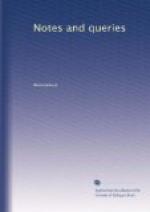August 12.
Fabulous Account of the Lion (Vol. ii., p. 142.).—Jarltzberg is right in supposing that this is given by Philippe de Thaun. It is, however, of older date. Turner (History of England during the Middle Ages, vol. iv. chap. iv. p. 209.) gives part of a Latin version of it from the “Physiologus” of a certain Theobald. The “Physiologus,” which is in substance the same as the “Bestiary” of Philippe de Thaun, occurs, according to Mr. Turner’s account of it, in MSS. of the eighth or ninth century. Anglo-Saxon versions of “The Whale and the Panther” are in the Codex Exoniensis. In the works of Hildebert, who died Abp. of Tours 1134, a poem called “Physiologus” is printed, which appears to be the same as that ascribed by Turner to Theobald. The fable and application of the Lion are the same as those given by Turner, with very trifling variations.
Among the poems ascribed to Abp. Hildebert is an “Epitaphum Magistri Theobaldi,” who, I conjecture, is the same Theobald as the supposed author of the “Physiologus.” It is rather long; but there is nothing to identify Theobaldus except the word “Dervensis.” What place this indicates I know not.
“Hoc vivente, locus Dervensis floruit,
isto
Sublato, marcet nominis hujus odor.”
Opera Hildeberti, p. 1322., Paris, 1708.
In the Opera Hildeberti there occur some verses on the symbols of the Evangelists. I subjoin them: though it is perhaps hardly worth while to print any more on this subject.
ON THE SYMBOLS OF THE EVANGELISTS.
“Matthaeum signat vir,
bos Lucain, leo Marcum, Ales discipulum
qui sine sorde fuit.
“Matthaeo species humana datur, quia scripto Indicat et titulo quid Deus egit homo. Os vituli Lucam declarat, qui specialem Materiam sumpsit de cruce, Christe tua. Effigiat Marcum leo, cujus littera clamat Quanta surrexit vi tua, Christi, caro. Discipulum signat species aquilina pudicum, Vox cujus nubes transit ad astra volans. Christus homo, Christus vitulus, Christus leo, Christus Est avis, in Christo cuncta notare potes. Est homo dum vivit, bos dum moritur, leo vero Quando resurgit, avis quando superna petit.”
Hildeberti Opera, Paris, 1708, p. 1318.
B.F.
Pomfret on the Thames (Vol. ii., p. 56.).—In a former number N. required to be informed where the Pons fractus, or Pountfreyt super Thamis, was situate, from whence several documents were dated by Edward II. This question has puzzled many learned antiquaries, and I do not think has ever been properly resolved. Both Pons fractus and Pountfreyt occur in Rymer’s Foedera, tomus iii., p. 904. Lond. 1706. If you will permit, I would hazard the conjecture that it was Kingston Bridge. Till within the last two centuries, the only bridges across the Thames were London and Kingston; and the latter in the thirteenth




